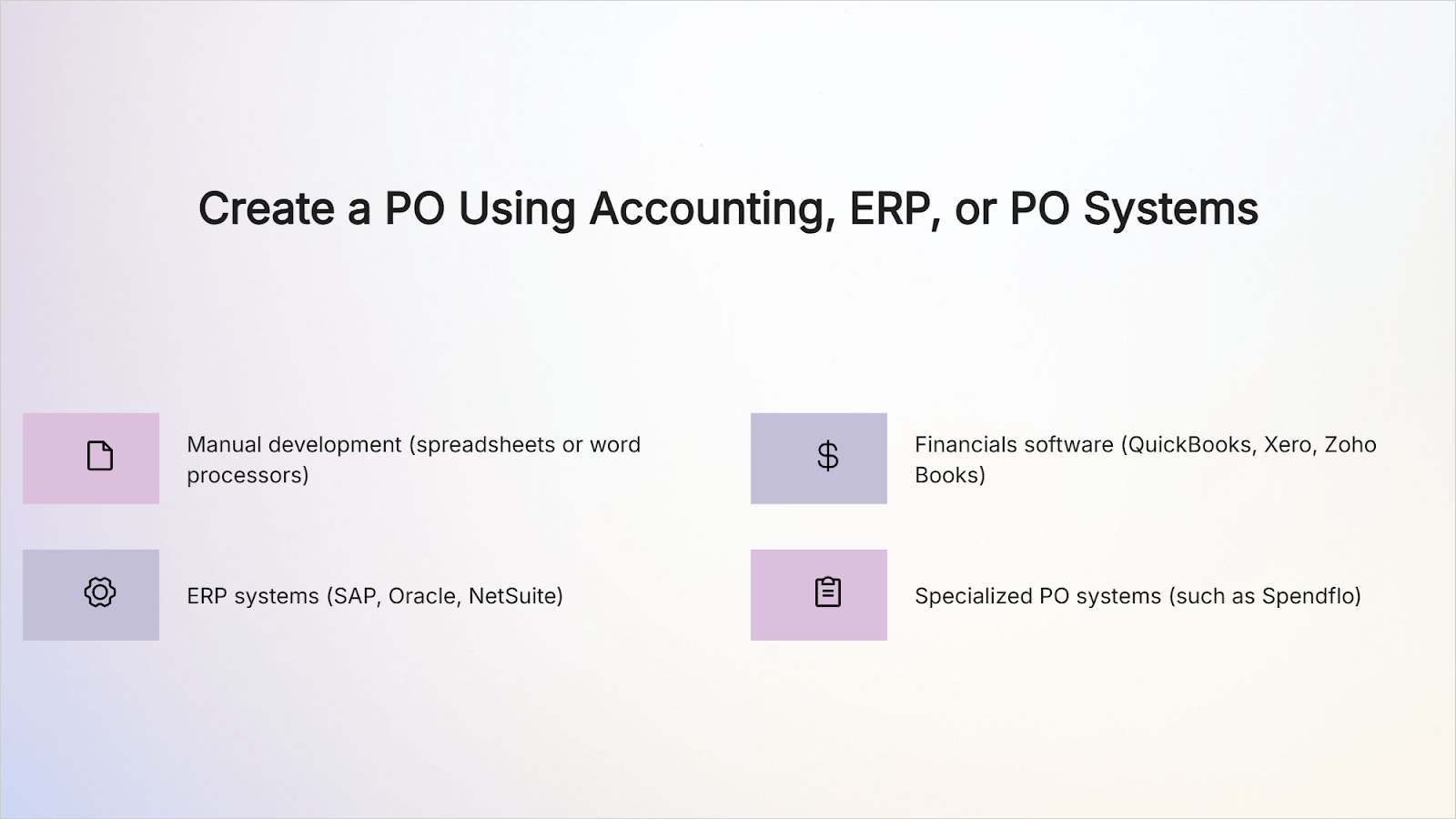

A Complete Guide to Creating Purchase Orders

A Complete Guide to Creating Purchase Orders
Learn how to create purchase orders efficiently, ensure accuracy, track spending, and use automation to streamline procurement with Spendflo.


According to a 2022 study by The Hackett Group, 61% of organisations reported operational inefficiencies in their purchase-order processes due to manual processes.
Creating a purchase order isn’t just filling out a form. It’s the document that states exactly what you’re ordering, who you’re buying it from, how much it costs, and under what terms. When this process is handled well, it keeps things clear between the buyer and the supplier, and it helps your business stay on track.
What Is a Purchase Order Creation?
Purchase order (PO) creation is the process of generating a formal document that authorizes the purchase of goods or services from a vendor. It outlines items, quantities, prices, and delivery terms. POs support financial control by preventing unnecessary spending, tracking commitments, and ensuring purchases align with approved budgets.
Steps to Creating a Purchase Order
A purchase order (PO) assists in formalizing the process of business purchasing and making sure that no purchase is made without adhering to the company policy. It is more like a legal agreement between buyer and supplier, which enhances accountability and avoids excessive expenditure. The following are steps of how to prepare a compliant purchase order.
1. Identify the need
It begins with a department identifying a need for goods or services. Purchase requisition is placed indicating the requirements, quantity required, and intended use. This document forms the grounds upon which any order is to be reviewed and approved.
2. Get approval
After the request has been generated, it is subjected to a finance/procurement review. They check whether the purchase is within budget constraints, internal policies, and project priorities. The approval ensures that the spending is reasonable and it assists in keeping the company finances under control.
3. Select a vendor
Once this is accepted, the procurement team will select an appropriate vendor according to pricing, quality of the product, reliability and delivery schedule. This can be done by evaluating existing contracts, comparing quotes or analysing vendor performance data. The aim is to get the most excellent price without losing quality.
4. Create the PO
With your procurement or accounting software, prepare a detailed purchase order. Add item descriptions, quantities, agreed price, terms and conditions of payment and delivery dates. It is also necessary to be accurate as the PO becomes a binding document when it is sent to the supplier.
5. Send for confirmation
The final PO is submitted to the vendor to view and accept. The vendor verifies the information and ensures that he is able to meet the order as required. This reassurance eliminates miscommunication and both the parties are comfortable with the pricing and terms before doing so.
6. Record and track
Once the PO is verified, it is entered into either the accounting system or the procurement system of the company. Tracking enables the order progress to be monitored and documentation to be prepared to match invoices and audit at a later stage. Financial transparency and accountability is also facilitated by proper recordkeeping.
7. Receive goods and reconcile
Upon delivery of the products/services, they are checked by the receiving team against the original PO. Any variation in quantity, quality or price is raised as a matter of review. Upon the completeness of this, the invoice is accepted to be paid, and the procurement cycle is complete.
Having a clear and consistent purchase order process is capable of minimizing delays and errors as well as aiding organizations to ensure compliance, improve operations, and enhance supplier relations.

Important Purchase Order Information
An adequate purchase order would not just be a product list or service list. It serves as a legal contract that provides the expectations of the buyer and the supplier. In order to maintain a transparent and legal transaction, ensure you add the following essential information in your PO.
1. PO number
Each purchase order is supposed to have a distinct reference number. With this identifier, it is simple to follow the order, approval, fulfillment, and payment. It also assists in funding teams to connect the PO with invoices and receipts.
2. Buyer and vendor details
Add full company names, billing and shipping address, and contact details of both parties. Such information proves the identity of the purchaser and the supplier of the goods or services so that there is no confusion during the trade.
3. Goods or services description.
Specify the objects under purchase, their specifications, purchase quantity, and unit of measure. Proper descriptions also make the suppliers provide the right products as well as provide you with an effective reference in the future of your receiving team to make quality checks.
4. Pricing and totals
Display unit prices, tax charges, and discounts, and the overall cost. Such detail ensures transparency and avoids billing errors. It also assists the procurement and the finance departments to manage their budgets more efficiently.
5. Delivery terms
Indicate shipment dates, places, and modes of transportation. This up-front definition prevents confusion concerning the time and place at which goods are supposed to be delivered. Proper delivery anticipations also contribute to keeping the suppliers responsible in terms of schedules and logistics.
6. Payment terms
Describe the method and timing of payment, the payment date, payment method (bank transfer or credit) and currency. Clear payment terms establish a mutual understanding between the two parties and ensure a healthy relationship between vendors.
7. Authorization details
Add the name and signature of the approving manager/department. This will ensure that the purchase is in accordance with company policy and it has been duly approved financially. It also establishes an effective audit trail in terms of compliance.
Comprehensive and documented purchase order eliminates confusion, minimizes the chances of disputes, and acts as a legal document between the two parties.
Sample Purchase Order Template
Below is a simple structure that most businesses follow:
Methods to Create a PO Using Accounting, ERP, or PO Systems
How you prepare purchase orders is determined by your organization size and tools you have to manage procurement. Every approach has its advantages and disadvantages, yet the objective is always the same, that is to maintain purchases in order, correct, and in accordance.
1. Manual development (spreadsheets or word processors)
Small businesses can begin with manual PO creation in Excel or word templates. Although this solution is effective with low transaction volumes, it is likely to experience data entry error and duplication. When the business is expanding, it can easily get hard to track approvals, version history and vendor records.
2. Financials software (QuickBooks, Xero, Zoho Books)
Some accounting systems have inbuilt PO templates which are related to expense categories and vendor profiles. This simplifies recording of purchases and their matching with invoices in future. Manual coordination of the approval processes and cross-department visibility may however be needed.
3. ERP systems (SAP, Oracle, NetSuite)
Enterprise resource planning (ERP) systems are normally utilized by larger organizations in creating and managing POs. These systems combine procurement and inventory, budgeting, and finance processes. They are good controls, yet may be difficult to set up and costly to maintain, and need the correct training and their own personnel.
4. Specialized PO systems (such as Spendflo)
The contemporary procurement system is tailored towards purchase order automation. There are also tools similar to Spendflo used to manage vendor data, approvals, and real-time budget tracking. They can be easily combined with accounting software and offer dashboards to track open POs, expenditure patterns and vendor performance.
Automation helps to make sure that nothing falls through the cracks. Having structured workflows, integrated approvals and real-time budget tracking, helps ensure teams are consistent in all purchases which eventually enhances visibility, accuracy and control of company spending.

Automating the Purchase Order Creation Process
Purchase orders made manually tend to slow down teams by using repetitive tasks, leaving out details and version issues. Automation enables the facilitation of the workflow process, which entails minimizing the number of mistakes, striving to ensure uniformity, and accelerating the approval process. It also gives full accessibility to all phases of the purchasing cycle.
1. Auto-generated PO numbers
Automation allocates unique PO numbers automatically so that there is no duplication and the tracking is easy. This facilitates more easy matching POs to invoices and delivery receipts at a later date to maintain your records in order and have them ready to be audited.
2. Built-in approval chains
Automatic routing enables purchase orders to reach the appropriate approvers without manual follow-ups. Managers are notified directly, and approvals are made in a shorter time. This will make the process adherent and minimize the unwarranted delays.
3. Budget controls
Automated systems are able to warn/ block POs exceeding approved budgets. This automated protection factor can keep finances in check. Budget visibility is also used to help teams to predict and distribute funds more precisely.
4. Vendor integration
Automation is directly linked to your vendor database, which automatically retrieves supplier information, pricing, and payment terms. This eliminates the possibility of making errors when entering the data and making sure that each PO possesses the latest and precise information.
5. Real-time visibility
The main dashboard will enable teams to monitor the progress of each PO, including its creation, approval, and delivery. This can be used to determine the bottlenecks early and enhance accountability within departments.
How Spendflo Simplifies PO Creation

Spendflo combines automation, visibility, and control. It’s designed to make your processes faster and more dependable, giving you peace of mind and more time to focus on what truly matters.
1. Construct POs on approved budgets or intake requests.
Spendflo connects requests and purchase orders to reduce the number of data entries. This ensures that all PO start with a proven business requirement and already approved budgets.
2. Automated approvals to the right stakeholders.
The approvals go through predefined workflows either departmental or amount of the spend or type of vendor. This helps save time in back and forth and saves teams an economic part of the time closing POs.
3. Connectivity with ERP/accounting systems.
Spendflo is integrated in such popular software as NetSuite, QuickBooks, and Xero. This ensures financial data consistency between tools and eliminates manual reconciliation and improves accuracy in reporting.
4. Keep track of vendor performance and renewal.
All the purchases are done at a single location such as purchase orders and renewals. Teams are able to monitor supplier reliability, spend patterns and contract performance in order to arrive at better sourcing decisions.
When Airmeet partnered with Spendflo, they transitioned from disjointed discovery and negotiation of software tools to a streamlined system where procurements happened three times faster and spend on vendor contracts was significantly reduced.
With Spendflo’s platform the PO lifecycle becomes transparent from request to payment and every stage is documented and under control. Organisations move from reactive ordering and spreadsheet chaos to predictable purchasing aligned with business goals and backed by data-driven decisions. Ready to elevate your PO process and make procurement an asset rather than a burden? Book a free demo with Spendflo today.
Frequently Asked Questions
1. What is purchase order creation?
Purchase order creation involves recording the decision of a company to purchase goods or services of a vendor. It contains information on the description of items, quantities, prices, and terms of payment. Upon approved purchase orders, the supplier and the buyer have the formal agreement which determines accuracy and accountability of the purchase order.
2. How to create a purchase order step by step?
The process starts with the need identification and a purchase requisition that is made. Once it is accepted, find a vendor and prepare a purchase order with all the details including items, prices and terms. Send PO to the supplier and confirm it, and record it in the accounting system. Upon receiving the goods or services, sum the PO with the invoice prior to making payment.
3. How to create your own PO?
A purchase order can be made using a spreadsheet, accounting tool or procurement platform like Spendflo on your part. Make sure that you have a distinct PO number, buyer and vendor information, description of product or service delivered, delivery schedules and payment terms. Check and authorize it within the company and only afterwards forward it to the supplier to ensure that there is appropriate documentation and control.
4. What is the 3-way PO process?
The 3-way PO process is an authentication procedure applied to validate the accuracy and then pay. It entails a three-document match, including purchase order, supplier invoice and goods receipt. When the quantity, price, and delivery conditions are the same, the payment may be verified. This assists in avoiding overbilling and keeping a proper record of financial transactions.










.png)




.png)




%20Questions%20to%20Ask%20Vendors.webp)





.avif)





